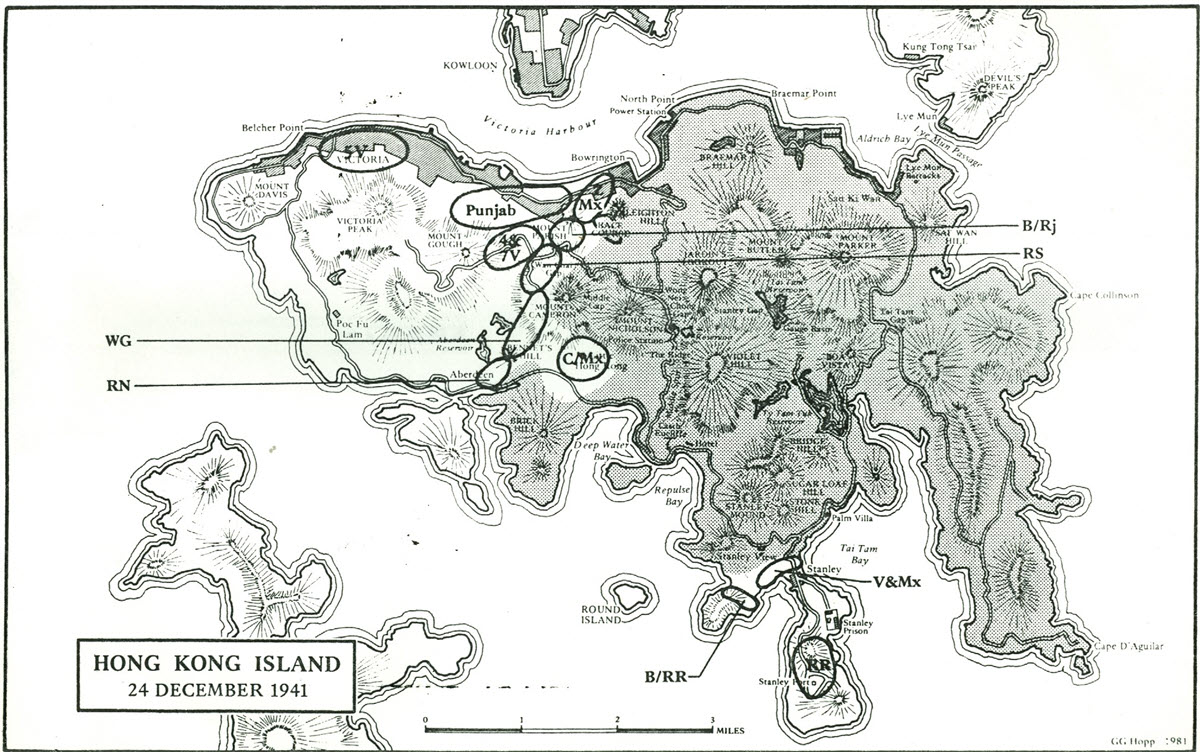The Island
—24 December
East Brigade
Christmas Eve dawned a fine, bright day. Tanaka's 2nd Battalion had begun moving west, out of the East Brigade area, while the 3rd Battalion was still at Repulse Bay licking its wounds. The two battalions brought over from the mainland, Tanaka's 1st and the 1st Battalion of Shoji's 230th Regiment, were maintaining a heavy pressure on the narrow Stanley front.
The front line had been subjected to continual artillery fire during the night to which only a few pillboxes were able to make a brief, probably futile reply with their machine-guns. At 10am Lieutenant Colonel Home and his Second-in-Command, Major Price, went back to Brigade Headquarters in the Officers' Mess of Stanley Prison, where a heated conference took place with Brigadier Wallis. Home was desperately concerned about the condition of his men: "No R.R.C. personnel had had any rest night or day for five days." 189-1 Men were not simply falling asleep, they were collapsing with fatigue and exhaustion. The Royal Rifles had done far more marching and fighting than any other component of the brigade, and officers and men were bitterly resentful of other units which they believed were not doing their fair share in the battle. This animosity was also shared by at least one of the Volunteer companies that had participated in several of the Rifles' actions. Resentment was particularly directed toward the Middlesex, two companies of which were now in the peninsula, but most of whom had never been placed in the front line, although they were no longer fighting from pillboxes. The Canadians were later to point out that when East Brigade surrendered, at least 2000 military prisoners of war were marched out by the Japanese. Some of this large number of soldiers could surely have been used during the battle to reinforce the Royal Rifles, who had held the line almost alone. The diary of the Royal Rifles records that Home "insisted that the battalion be relieved otherwise he would not be responsible for what would happen.” 190-2 Maltby was brought into the discussion by telephone, and the end result was an agreement that relief would be sent in that evening for the Rifles, who could then move into Stanley Fort further down the peninsula to rest and re-organize. Orders were issued that afternoon, and by 11pm the Rifles' positions were occupied by men of the Middlesex and Volunteers and the Rifles were in Stanley Fort, where all ranks promptly collapsed.
The exception was B Company which, except for two platoons, was on the adjacent Chung Hum Kok Peninsula. The company had already seen action in its new position, driving off a Japanese patrol. In the early morning the two platoons that had inadvertantly ended up in Stanley tried to reach their company, but were overtaken by daylight before they could cross the main stretch of open ground, now commanded by the enemy, so the attempt was abandoned. That night a Volunteer force was detailed to relieve B Company so it could rejoin the rest of the battalion at Stanley. Unfortunately, the Volunteers were ambushed, so B Company was forced to remain in its isolated position.
West Brigade
Along many sectors of the West Brigade forward line Christmas Eve was uneventful, if this term can possibly be employed to describe a continuous bombardment from Japanese aircraft, mortars, and artillery. The men of the Middlesex Z Company on Leighton Hill were attacked that afternoon by about 200 of the enemy following an unusually heavy bombardment. The Japanese, infiltrating through the buildings, moved in on Leighton Hill from three sides and the defenders were ordered to retreat before they were surrounded. During the withdrawal the company suffered more than 25% casualties. Z Company had held Leighton Hill with their machine-guns for more than five days, resisting both the pressure of the Suzukawa Engineering Unit and the exhausting ordeal of continuous bombardment and shelling from the mainland and the Island. The final assault from the advance guard of the Japanese infantry was simply too much.

That evening another convoy made it through to Little Hong Kong, bringing in Royal Scots and Middlesex reinforcements and taking out ammunition. There was also considerable patrol activity, particularly in the Grenadier and Royal Scots sectors. The defenders needed to find out as much as possible about enemy activities and possible intentions, and with the loss of the high ground, patrolling was the only method remaining. There was one particularly fierce patrol clash on the Grenadier front at 9:30pm.
Major General Maltby must have seen the handwriting on the wall when at 10pm, Christmas Eve, he received reports from the southern sector of his line that there was "a general move of the enemy from Mount Nicholson/Mount Cameron area northwards towards the Race Course." 192-3 This was the Japanese main infantry force. Doi's and Shoji's regiments were moving in for the kill.